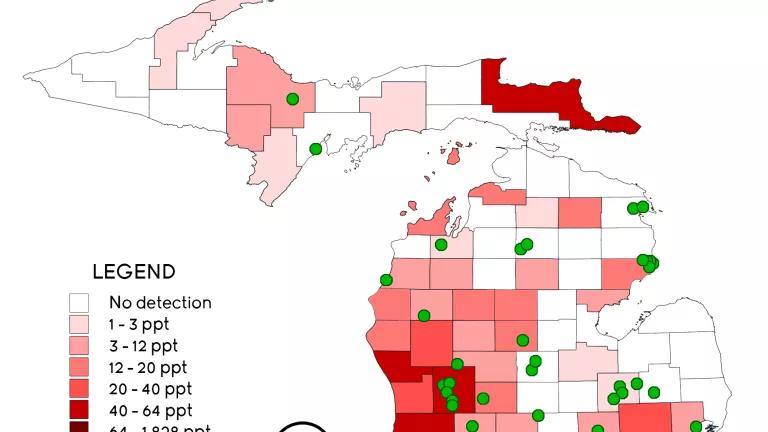Michigan Should Set Precedent-Setting PFAS Water Standards

Today the Natural Resources Defense Council filed an extensive scientific report making a detailed case for the Michigan Department of Environmental Quality (MDEQ) to establish strict drinking water standards for five chemicals within the PFAS class. We also requested that MDEQ issue a “treatment technique” standard, based upon best available water treatment technology, to clean up the entire PFAS class of chemicals from contaminated tap water.
The extensive scientific analysis included a review of the toxicological and epidemiological evidence demonstrating the threats to health from PFAS, and an engineering review of the best available technologies to test for and remove PFAS from drinking water (“scientific report”).
NRDC also is asking that the Michigan legislature and Congress work with the Governor to provide funding to help water systems pay for safe water. We also urge that action be taken to ensure that polluters responsible for threatening or contaminating water supplies pay for cleanup, and that affordability programs be adopted that will help low-income people and communities pay for their drinking water.
PFAS Contaminated Public Water Supplies and Sites in Michigan
What are PFAS?
As discussed in the scientific report, poly- and perfluoroalkyl substances (PFAS) are chemicals widely used in nonstick cookware, to grease-proof food packaging, and for stain and water-resistance on clothing, carpets, and furniture. They are also used in cosmetics and in “aqueous film forming foam,” which is used, for example, at airports and military facilities in training exercises and to suppress fires. There are more than 4,700 PFAS chemicals in the class that have been cleared for use. PFAS unfortunately tend to share three problematic properties:
- PFAS are highly persistent “forever chemicals” that do not break down easily and can accumulate in the bodies of people and food that we eat;
- PFAS are highly mobile and spread quickly in the environment and are found in our drinking water, air, food, and homes;
- PFAS are highly toxic and can be harmful at extremely low doses (in the low part per trillion levels).
Health Risks Posed by PFAS
As reviewed in the scientific report, PFAS have been linked to a wide range of serious illnesses, some of which can occur at very low levels of exposure. For example, a massive study of 69,000 people exposed to PFAS in their drinking water in the vicinity of a factory in West Virginia found that certain PFAS are likely linked to cancer of the kidneys and testicles, thyroid disease, pregnancy-related hypertension, high cholesterol that can lead to heart disease, and the autoimmune disease ulcerative colitis. Other studies reviewed in the scientific report have confirmed many of these findings and have shown that PFAS are also linked to lower fertility in women; harm to developing fetuses, infants and children; liver disease; and weakened immune systems.
Widening PFAS Crisis: A National Threat Hits Michigan Hard
Just two members of this class of toxic chemicals, PFOA and PFOS, are present in the tap water of at least 6 million Americans at levels in excess of EPA’s weak and unenforceable ‘health advisory” for those chemicals, according to an analysis led by Harvard researchers. This analysis, based on limited sampling required by the EPA 4 years ago, found PFAS contamination in the drinking water of 16.5 million people in 33 states. Based on the limited testing done to date, it appears likely that tens of millions of Americans are served tap water containing PFAS at levels as much as hundreds of times higher than what the Centers for Disease Control and Prevention (CDC) and independent scientists consider acceptable.
While the PFAS problem is national, Michigan has conducted its own additional monitoring, the most comprehensive in the country, which has found widespread contamination. State testing near industrial facilities, military bases, and landfills known to have used or disposed of PFAS-containing compounds has found multiple sites with PFAS contamination, sometimes exceeding EPA’s unenforceable health advisories. However, these data likely understate the contamination problem. While MDEQ is investigating just over 40 contamination sites, the agency reportedly has suggested that statewide, far more sites could be contaminated with PFAS.
Widespread Contamination in Michigan’s Public Water Supplies
MDEQ commendably has tested for certain PFAS in over 1,100 Michigan public water systems, and has publicly reported the results. The Michigan testing has found PFOA, PFOS and other PFAS in more than 100 public water systems. This State testing found PFAS in the drinking water of over 1.4 million Michiganders in 2018, across the state. As of February 26, 2019, at least 78 samples from public water systems tested positive for PFOA and PFOS, with levels as high as 1,520 ppt (compared to EPA’s 70 ppt health advisory). At least 162 samples from water systems tested positive for at least one PFAS, with concentrations up to 1,828 ppt. This additional testing was not required by EPA. Importantly, reporting limits for PFAS testing by MDEQ are substantially lower than those used under EPA’s unregulated contaminant monitoring rule that produced the data analyzed in the Harvard study noted above. This means that Michigan’s testing reports lower levels of contamination than was picked up by the older EPA data. This is important because CDC and other independent scientists have concluded that levels of many PFAS pose health risks at the low part per trillion level, sometimes well below EPA’s reporting limits.
Our Request: Health-Protective Drinking Water Standards
In order to address the extraordinary health threat posed to citizens across the state from widespread contamination of drinking water with PFAS, NRDC is requesting that MDEQ issue Maximum Contaminant Level Goals (MCLGs) and enforceable Maximum Contaminant Levels (MCLs) for 5 PFAS for which there are substantial toxicological data. We further ask MDEQ to set an MCLG and a Treatment Technique for total PFAS.
MCLGs are non-enforceable thresholds set at a level at which no harmful health effects should occur, with an adequate margin of safety (i.e. completely protective of health). The report recommends that these MCLGs be set at zero. This recommendation is based upon health risks, including cancer and other effects observed in scientific studies, where there is no clear “safe” threshold of exposure, and where these contaminants cause effects at vanishingly low-levels. The report further suggests that MDEQ issue MCLs for five PFAS that are as close to the MCLGs of zeros as “feasible” based upon the best available treatment and detection technologies (4 of the 5 PFAS can be measured reliably down to 2 ppt, and GenX down to 5 ppt, all can be treated to below detection levels). Further, the report suggests that MDEQ establish a “treatment technique” for the sum of all PFAS, based upon reverse osmosis treatment, or a treatment that is equally as effective. This treatment technique is needed because there are thousands of PFAS cleared for use and evidence is mounting that the class collectively poses a threat to human health and the environment. If only a handful of PFAS are regulated, there will be swift regrettable substitution with other, similarly toxic PFAS - creating an ongoing problem where addressing one chemical at a time incentivizes the use of other toxic chemicals and we fail to establish effective safeguards to limit this growing class of dangerous chemicals.
RECOMMENDED PFAS DRINKING WATER STANDARDS
|
CONTAMINANT |
MCLG |
MCL OR TREATMENT TECHNIQUE |
GROUNDWATER CLEANUP STANDARD |
|
PFOA |
0 |
2 ppt |
2 ppt |
|
PFOS |
0 |
2 ppt |
2 ppt |
|
PFNA |
0 |
2 ppt |
2 ppt |
|
PFHxS |
0 |
2 ppt |
2 ppt |
|
GenX |
0 |
5 ppt |
5 ppt |
|
TOTAL PFAS |
0 |
Treatment Technique: Reverse Osmosis or Equivalent |
|
Ensuring Funding for Cleanup, that Polluters Pay, and that Water Is Affordable
Finally, we are calling upon the Michigan legislature to work closely with Governor Whitmer to ensure that funds are available to clean up the pollution and that low-income consumers can afford their water bills. The legislature should work with the Governor to enact legislation that will assist communities in paying to address their drinking water problems—from PFAS pollution, lead contamination, or other issues. The state also should ask Congress to enact such infrastructure legislation, but we cannot wait for Congressional action to move forward. Michiganders need safe water now, not years from now. Furthermore, those responsible for the PFAS or other pollution should be required to pay to clean up our water. The Attorney General has some authority to bring polluters to account for their PFAS pollution, and certain legal doctrines can be applied to hold polluters accountable to clean up, but it would be best if PFAS were included in the list of “hazardous substances” that are explicitly authorized to be addressed under Superfund. Moreover, the state legislature could enact legislation explicitly requiring polluters to pay for clean up and to remedy the harms they have caused. These actions should help make water more affordable, but ultimately water systems, localities and state authorities should adopt strong water affordability programs that ensure that low-income consumers can afford to pay their water bills.





